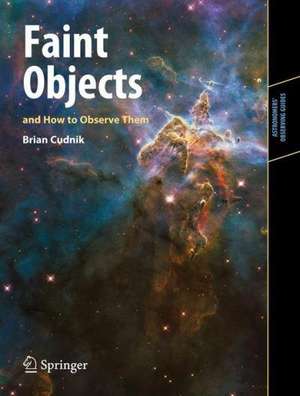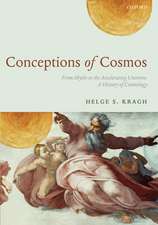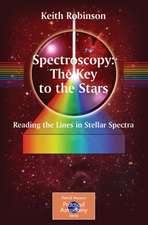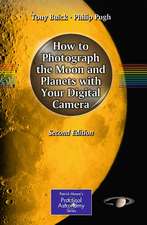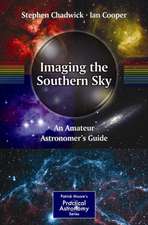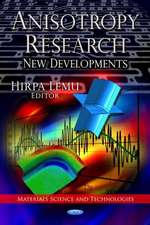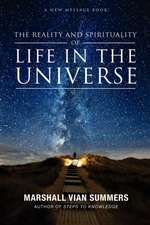Faint Objects and How to Observe Them: Astronomers' Observing Guides
Autor Brian Cudniken Limba Engleză Paperback – 18 sep 2012
Din seria Astronomers' Observing Guides
-
 Preț: 183.23 lei
Preț: 183.23 lei -
 Preț: 196.41 lei
Preț: 196.41 lei -
 Preț: 189.37 lei
Preț: 189.37 lei -
 Preț: 193.12 lei
Preț: 193.12 lei -
 Preț: 184.28 lei
Preț: 184.28 lei -
 Preț: 329.89 lei
Preț: 329.89 lei -
 Preț: 273.58 lei
Preț: 273.58 lei -
 Preț: 275.79 lei
Preț: 275.79 lei -
 Preț: 280.19 lei
Preț: 280.19 lei -
 Preț: 254.46 lei
Preț: 254.46 lei -
 Preț: 251.37 lei
Preț: 251.37 lei -
 Preț: 285.68 lei
Preț: 285.68 lei -
 Preț: 213.79 lei
Preț: 213.79 lei -
 Preț: 254.90 lei
Preț: 254.90 lei -
 Preț: 298.02 lei
Preț: 298.02 lei -
 Preț: 217.51 lei
Preț: 217.51 lei -
 Preț: 300.38 lei
Preț: 300.38 lei -
 Preț: 270.71 lei
Preț: 270.71 lei -
 Preț: 345.09 lei
Preț: 345.09 lei -
 Preț: 342.13 lei
Preț: 342.13 lei -
 Preț: 246.30 lei
Preț: 246.30 lei -
 Preț: 210.90 lei
Preț: 210.90 lei
Preț: 256.78 lei
Nou
Puncte Express: 385
Preț estimativ în valută:
49.14€ • 53.36$ • 41.28£
49.14€ • 53.36$ • 41.28£
Carte tipărită la comandă
Livrare economică 18-24 aprilie
Preluare comenzi: 021 569.72.76
Specificații
ISBN-13: 9781441967565
ISBN-10: 1441967567
Pagini: 263
Ilustrații: XXII, 241 p. 78 illus., 51 illus. in color.
Dimensiuni: 177 x 235 x 20 mm
Greutate: 0.61 kg
Ediția:2013
Editura: Springer
Colecția Springer
Seria Astronomers' Observing Guides
Locul publicării:New York, NY, United States
ISBN-10: 1441967567
Pagini: 263
Ilustrații: XXII, 241 p. 78 illus., 51 illus. in color.
Dimensiuni: 177 x 235 x 20 mm
Greutate: 0.61 kg
Ediția:2013
Editura: Springer
Colecția Springer
Seria Astronomers' Observing Guides
Locul publicării:New York, NY, United States
Public țintă
Popular/generalCuprins
Preface.- Pushing the Envelope in Visual Astronomical Observations.- Part I: The Physical Nature of Faint Objects.- Chapter 1: The Astronomical Surveys.- Chapter 2: The Astronomers Behind the Historical Surveys.- Chapter 3: The Nature of Star Clusters and Nebulae.- Chapter 4: The Nature of Galaxies and Galaxy Clusters.- Chapter 5: The Nature of Quasars and Other Exotics.- Chapter 6: Ground-and Space-Based Observations of the Most Distant Parts of the Universe.- Part II: How to Observe Faint Objects.- Chapter 7: General Guidelines for Observing Faint Objects.- Chapter 8: Preparation and the Observing Session.- Chapter 9: Some Suggested Observing Projects.- Chapter 10: Suggested Projects by Survey and Source.- Chapter 11: Recording Your Observations and Other Tips to Help You Stick with the Program.- Chapter 12: Citizen Science Activities and Searching for Supernovae.- A Few Final Thoughts.- Appendix A: References and Footnotes.- Appendix B: Glossary.- Appendix C: Resources Useful for the Observation of Faint Objects.- Appendix D: Observing Software.- Appendix E: Astronomical League Observing Clubs.- Appendix F: How to Find More Observing Lists of Faint Objects.- Index.
Notă biografică
Brian Cudnik has been an amateur astronomer for over 30 years and manages the Physics laboratories at Prairie View A& M University (a part of the A&M University of Texas). He has been the coordinator of the Lunar Meteoritic Impact Search section of the Association of Lunar and Planetary Observers (ALPO) since January 2000. Cudnik began at ALPO two months after it made the first confirmed visual observation of a meteoroid impact on the Moon during the Leonid storm of November 1999. Cudnik has an MSc and has published papers and posters on various astronomical subjects, both peer-reviewed and amateur. He has served as a board member of the Houston Astronomical Society, is presently an Associate member of the American Astrononmical Society, a member of the American Association of Variable Star and a regular contributor of observations to the International Occultation Timing Association. He teaches astronomy at the University of St. Thomas two evenings per week each semester.
Textul de pe ultima copertă
Astronomers' Observing Guidesprovide up-to-date information for amateur astronomers who want to know all about what it is they are observing. This is the basis of the first part of the book. The second part details observing techniques for practical astronomers, working with a range of different instruments.
Faint Objects and How to Observe Them is for visual observers who want to "go deep" with their observing. It's a guide to some of the most distant, dim, and rarely observed objects in the sky, with background information on surveys and object lists -- some familiar and some not.
Typically, amateur astronomers begin by looking at the brighter objects, and work their way "deeper" as their experience and skills improve. Faint Objects is about the faintest objects we can see with an amateur's telescope -- their physical nature, why they appear so dim, and how to track them down.
By definition, these objects are hard to see! But moderate equipment (a decent telescope of at least 10-inch aperture) and the right techniques can reveal a surprising number of 'almost invisible' objects. The book provides basic tips on the type of telescope to use, how to record observations, and where to find lists and those all important finder charts.
Here is a "one-stop shop" for those who are interested in taking their observational pursuits to the next level, and who want to see the most distant parts of the universe accessible to backyard telescopes.
Faint Objects and How to Observe Them is for visual observers who want to "go deep" with their observing. It's a guide to some of the most distant, dim, and rarely observed objects in the sky, with background information on surveys and object lists -- some familiar and some not.
Typically, amateur astronomers begin by looking at the brighter objects, and work their way "deeper" as their experience and skills improve. Faint Objects is about the faintest objects we can see with an amateur's telescope -- their physical nature, why they appear so dim, and how to track them down.
By definition, these objects are hard to see! But moderate equipment (a decent telescope of at least 10-inch aperture) and the right techniques can reveal a surprising number of 'almost invisible' objects. The book provides basic tips on the type of telescope to use, how to record observations, and where to find lists and those all important finder charts.
Here is a "one-stop shop" for those who are interested in taking their observational pursuits to the next level, and who want to see the most distant parts of the universe accessible to backyard telescopes.
Caracteristici
Provides a unique and up to date collection of facts about the physical nature of distant faint objects Greatly enhances the appreciation of the visual appearance of a faint object in the eyepiece Has the potential to renew the interest of those who have observed well-known deep sky objects and want a greater challenge
